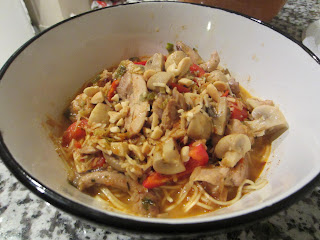Not your usual tom yum noodle soup, but the ultimate comfort food for a cold winter's night.
The marinade for the chicken was mostly an experiment and the quantities can be varied. I was also out of coconut milk but found some shredded coconut in my pantry - it worked surprisingly well!
Ingredients
- 200g chicken thigh, sliced
- 2 baby (or 1 medium) capsicums, sliced
- 10 small button mushrooms, quartered
- 200g dried egg noodles
- 2 tbsp palm sugar, grated
- 2 tbsp coriander, chopped
- 1 tbsp basil, chopped
- 2 stalks spring onion, chopped
- 1 chilli, chopped
- 2 cloves garlic, chopped
- 1 tbsp ginger, grated
- 1/2 cup shredded coconut
- 1/2 tsp fish sauce
- juice of 1/2 lime
- 2 tbsp tom yum paste
- 1/2 cup cream (ideally, use coconut cream or coconut milk)
- chicken stock
- vegetable oil
- salt
Method
- Combine sugar, coriander, basil, spring onion, garlic, chilli, ginger, shredded coconut, 2 tablespoons of oil, fish sauce and lime juice. Blitz until a rough paste forms. Pour mixture over chicken and massage paste into chicken pieces. Leave to marinate for at least 10 minutes.
- Cook egg noodles according to packet instructions. Drain and portion into large bowls.
- Heat oil in a wok and fry chicken until browned and aromatic. Add a little water to help the chicken cook through. When chicken is cooked, add capsicum and toss through chicken. Remove chicken and capsicum from wok with tongs and divide among bowls. Leave any excess sauce in the wok.
- Fry up mushrooms in the leftover sauce and tom yum paste. Add stock to deglaze the pan and bring to boil. Add cream to thicken soup and add salt to taste.
- Ladle soup over chicken and noodles. Garnish with crushed peanuts.
 |
| Thai chicken tom yum noodle soup |








